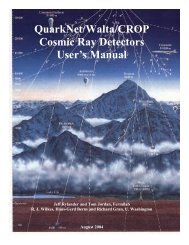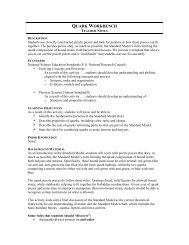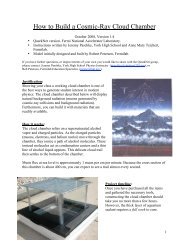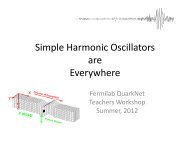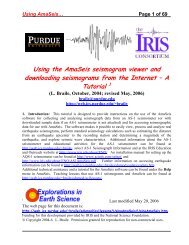Teaching Modern Physics - QuarkNet - Fermilab
Teaching Modern Physics - QuarkNet - Fermilab
Teaching Modern Physics - QuarkNet - Fermilab
You also want an ePaper? Increase the reach of your titles
YUMPU automatically turns print PDFs into web optimized ePapers that Google loves.
Teacher’s Key<br />
Circular Motion Problems<br />
1. A proton in the <strong>Fermilab</strong> Tevatron (a circular particle accelerator) has a momentum of<br />
980 GeV/c. If the radius of the Tevatron is 1 km (it is), calculate the magnetic field<br />
necessary to accomplish this.<br />
Need to convert “particle physics” momentum to “normal” momentum. Then it is a<br />
simple case of using the formula for circular motion.<br />
p = 980 GeV/c = (980 × 10 9 eV) (1.602 × 10 -19 J/eV)/(3 × 10 8 m/s) =<br />
5.2 × 10 -16 kg m/s<br />
F = m v 2 /r = q v B → p = q r B → B = p/(q r) = 3.3 T<br />
2. The <strong>Fermilab</strong> accelerator is designed to use magnetic fields to make protons orbit in a<br />
circular path with a radius of 1 km. The magnetic field strength can be changed. If<br />
protons are injected into the accelerator with an initial energy of 120 GeV and are<br />
accelerated to a final energy of 980 GeV, calculate the ratio of the final to initial<br />
magnetic field.<br />
F = m v 2 /r = q v B → p = q r B → B = p/(q r)<br />
Thus,<br />
Bfinal/Binitial = [p/(q r)]final / [p/(q r)]initial = 980/120<br />
B980 GeV = 8.2 B120 GeV<br />
3. A particle physics detector consists of a circular region of radius 50 cm filled with air,<br />
surrounded by an extended region filled with metal. The air-filled region contains a<br />
magnetic field with strength 2 T, directed out of the page in the attached diagram. A<br />
proton is emitted from the center of the circle with momentum p in the plane of the paper<br />
and directed radially outwards from the center. Calculate the maximum p for which the<br />
proton will not hit the metal region.<br />
This problem is mildly tricky, as one can do it a hard way and an easy way. The first<br />
thing to realize is that if the radius of the magnetic field region is 50 cm, then a particle<br />
originating at the center of the cylinder will have to travel with a radius of curvature of<br />
25 cm to fit fully within the magnetic region. The next thing one has to do is to convert<br />
the “particle physics momentum,” with its units of GeV/c to “normal momentum.”<br />
19




